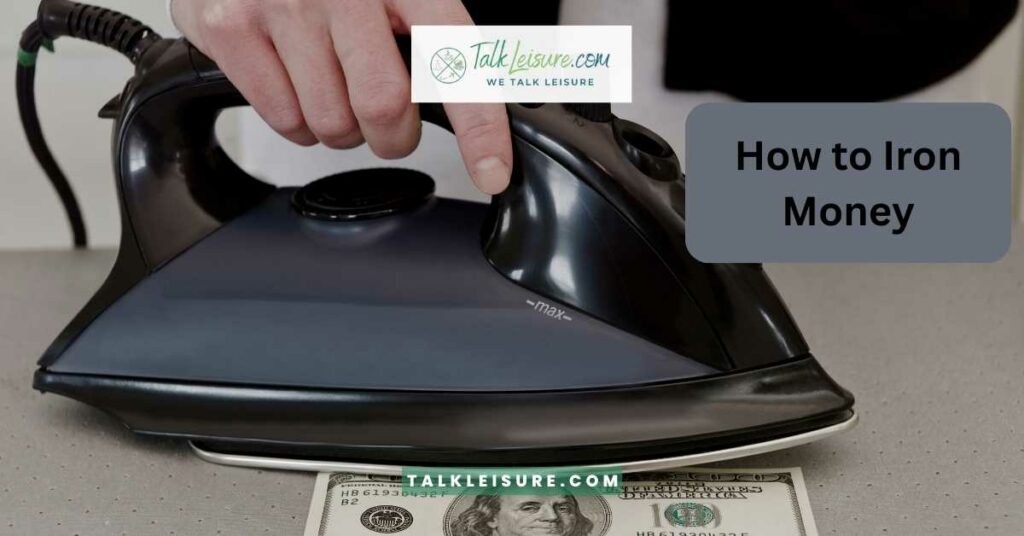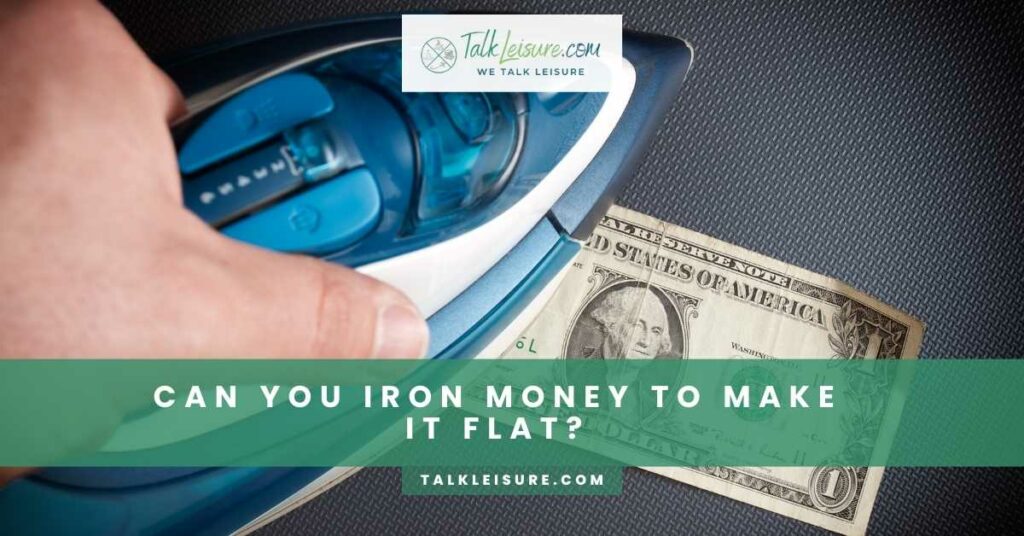Have you ever found a crumpled dollar bill at the bottom of your pocket or purse?
Or perhaps you received a wrinkled banknote as change from a store.
In such situations, have you ever considered using an iron to make the money flat again?
It’s a common question that many people ask.
Can you iron money to make it flat? Well, today we will explore this curious subject and find out the truth behind it.
So grab your iron and let’s dive in!
Introduction
In this blog post, readers will find the answer to one of the most common money questions.
The question is, Can You Iron Money To Make It Flat?
The goal of the blog is to give a step-by-step guide on how to iron money, including what you need, how to prepare the iron, how to prepare the money, how to iron the money, and how to cool the money.
The blog will also talk about what happens to paper money when it gets hot and give an overview of the laws about defacing or changing money.
Aside from ironing, the readers will also learn about other ways to flatten money, like using a rolling pin, putting it in a book and pressing down on it, putting it on a flat surface, or using a professional machine for flattening money.
By the end of the blog, readers will know everything they need to know about how to flatten their money and how to do it.
How to Iron Money

To iron money, there are a few easy steps to follow.
First, gather necessary materials including a spray bottle, a dry cloth, and an iron.
Next, prepare the iron by setting it to a low heat or silk setting.
It is important not to use high heat because this could damage the money.
Then, dampen the wrinkled money with water from the spray bottle or sprinkle it by hand.
Smooth out the bills and place them on a dry cloth.
Iron the money by applying gentle pressure to the bills with the iron, moving it in a straight back-and-forth motion.
Finally, cool the money on the dry cloth to prevent re-wrinkling.
It is important to avoid creasing or folding the money.
These simple steps can help straighten out crumpled bills and make them look new again.
Gather Necessary Materials
To get started with ironing money, it’s important to gather the necessary materials beforehand. As previously mentioned, you’ll need an iron, an ironing board or a flat surface, and a spray bottle filled with water.
It’s also recommended to have a clean and well-maintained iron to avoid dirty stains on your money.
Before proceeding, check the iron-safe symbol on the money to ensure that it can be ironed without causing any damage or alteration to its design.
It’s always better to be safe than sorry so it’s best to check labels first.
In addition, make sure to choose a well-lit and well-ventilated area to iron your money.
With these materials ready, you can proceed with the next steps of preparing and ironing your money.
Preparing The Iron
Now that you have all the things you need, it’s time to get the iron ready.
First, fill the iron with water that has been distilled or filtered.
This is important because impurities in regular tap water can leave marks or stains on your bills.
Put the iron on a low heat, somewhere between 100 and 150 °C.
Make sure to test the heat on a scrap piece of paper first to make sure the bills won’t burn or get damaged.
Also, it’s best to use an iron that doesn’t have a steam setting, since steam can make the bills wrinkle even more.
Once the iron is hot and ready to go, get the money ready to be ironed.
Preparing The Money
Before ironing the money, it is important to properly prepare it.
Start by dampening the wrinkled bills with water from a spray bottle or by sprinkling water with your hand.
Be careful not to soak the money as this could cause further damage.
Once dampened, gently flatten the currency by pressing it onto a soft surface to avoid tearing.
This will also prevent the material from sliding while ironing.
It is important to note that paper money in the USA is designed to meet stringent requirements and thus, should be handled carefully.
To avoid defacing or altering currency, it is essential to familiarize oneself with the laws surrounding the issue.
Overall, with proper preparation, ironing can be an effective way to flatten money, but there are also alternative methods, such as using a rolling pin or professional money flattening machine.
Ironing The Money
Now that you have gathered the necessary materials and prepared your iron and money, it’s time to iron your bills to make them flat.
Remember to set your iron to low heat and use a circular motion when pressing the money against a smooth surface.
Be careful not to apply too much pressure or iron the bills with dry heat, as this can cause the money to flame.
Once your bills are ironed flat, set them aside to cool.
While ironing money is an effective way to make it flat, it’s important to note that steaming or ironing notes diminishes their value.
If you’re looking for alternative ways to flatten your money, you can use a rolling pin, place it in a book and apply pressure, or use a professional money flattening machine.
Cooling The Money
Once the money has been ironed, you should wait until it is completely cool to touch it again.
The heat from the iron can make the money very hot, so you should wait for it to cool down before touching it.
If you touch the money too soon, you might get it dirty or hurt it, which could make it useless.
Also, it’s important not to press the money too hard on the ironing board, because doing so can cause the thin paper to bend or tear.
The best way is to tap the iron slowly and carefully.
Make sure the money is completely flat before you put it away after it has cooled.
Remember that taking care of your money will help it last and be useful.
Does Heat Affect Paper Money?
Did you know that applying heat to paper money can cause damage to the bills?
Paper-based bills are made from a blend of cotton and linen, and ironing them can be safe if done correctly.
However, exposing them to high temperatures or open flames can cause the bills to burn, melt or shrink.
It’s important to handle paper money with care to ensure it remains in good condition.
Polymer notes, which are used in many countries, are also sensitive to high temperatures, which can cause them to shrink or melt.
It’s crucial to avoid flattening or ironing your bills in order to avoid damaging them.
Are You Allowed to Iron Money? Overview of laws regarding defacing or altering currency
It is important to note that altering or defacing currency is illegal under the Monetary Law Act.
This includes ironing or using any other method to flatten or manipulate the appearance of money.
In fact, the law prohibits individuals from melting, perforating, mutilating or breaking up coins as well.
Similarly, Bank note portraits are protected and cannot be altered, except to make them smaller or larger in proportion.
While it may seem harmless to iron money to make it flat, it can be considered defacing, and therefore, against the law.
It is crucial to respect the legal limitations surrounding currency in order to avoid any legal repercussions.
How Can I Make My Money Flat? Other Ways Except Ironing
While ironing is one way to make your money flat, there are alternative methods that may be more suitable for certain situations.
One option is to use a rolling pin to apply even pressure to the bills, starting from the center and rolling outward.
Another method is to place the money in between the pages of a heavy book and leaving it there for a few hours or overnight.
For a more professional approach, there are machines specifically designed for flattening currency.
Whichever method you choose, it’s important to be gentle with the bills to avoid damaging them.
It’s worth noting that ironing or altering money in any way is against the law in some countries, so make sure to check your local laws and regulations before attempting any method of flattening currency.
Use a Rolling Pin
Another way to make money flat, without using an iron, is to use a rolling pin.
This simple tool is perfect for making round shapes and can also help flatten out money.
To do this, place the money on a flat surface and place a clean cloth on top of it.
Then, use the rolling pin to apply gentle pressure to the cloth and money, rolling it back and forth until the money is flat.
It’s important to keep the pressure low to avoid damaging the paper.
This method is especially useful for smaller bills or loose change.
With this technique, there’s no need to spend money on pricey equipment or worry about damaging your money with excessive heat.
Put It in a Book and Apply Pressure
Another way to make your money flat without using an iron is to put it in a book and apply pressure.
Simply place your bill in between the pages of a heavy book, such as a dictionary or encyclopedia, and close the book tightly.
Leave it there for a few hours or even overnight, and the weight of the book will apply enough pressure to flatten out any wrinkles or creases in the paper.
This method is especially useful if you are hesitant to use heat on your paper money.
Overall, there are several simple ways to make your money flat and presentable, whether you choose to use an iron, a rolling pin, or the pressure of a book.
It all comes down to personal preference and what materials you have readily available at home.
Using a Flat Surface
Another way to make your money flat is by using a flat surface.
This method is especially useful when you don’t have access to an iron or other tools for flattening your bills.
Simply lay your bill on a flat and sturdy surface, like a table, desk, or countertop.
Then, use your hand or a smooth object like a credit card to gently press down on the bill, applying even pressure across the entire surface.
Repeat this process until the bill is flat and free of wrinkles.
Using a flat surface is a safe and easy method for flattening your money, but it may take longer than other methods.
Nonetheless, patience and perseverance will get the job done.
Using a Professional Money Flattening Machine
If you’re not sure about the idea of ironing your money, you could buy a machine that does it for you.
These machines are made to flatten paper money without doing any damage to it.
They work by gently pressing on the bill to smooth out any creases or wrinkles.
Even if they are expensive, professional machines are safer than ironing, especially if you are dealing with rare or valuable money.
But it’s important to remember that using a money flattening machine doesn’t guarantee that your bill will be completely flat, as some wrinkles may be too hard to get rid of.
In the end, the choice of whether to iron Money yourself or use a professional machine comes down to personal preference and how much money you have.
No matter which method you choose, make sure to be careful with your money and follow any laws about defacing or changing money.
Conclusion
In conclusion, ironing money is a viable way of making it flat.
However, it is important to take precautions, such as using the right temperature and avoiding direct contact with the iron.
While ironing can flatten your money, other methods such as using a rolling pin, putting it in a book and applying pressure, or using a professional money flattening machine can also work just as well.
It is important to note that laws prohibit defacing or altering currency in certain ways, and so caution should be exercised when attempting to flatten money.
In the end, the goal is to make your money look neat and presentable, and any of these methods can help achieve that.
Best Wishes!












